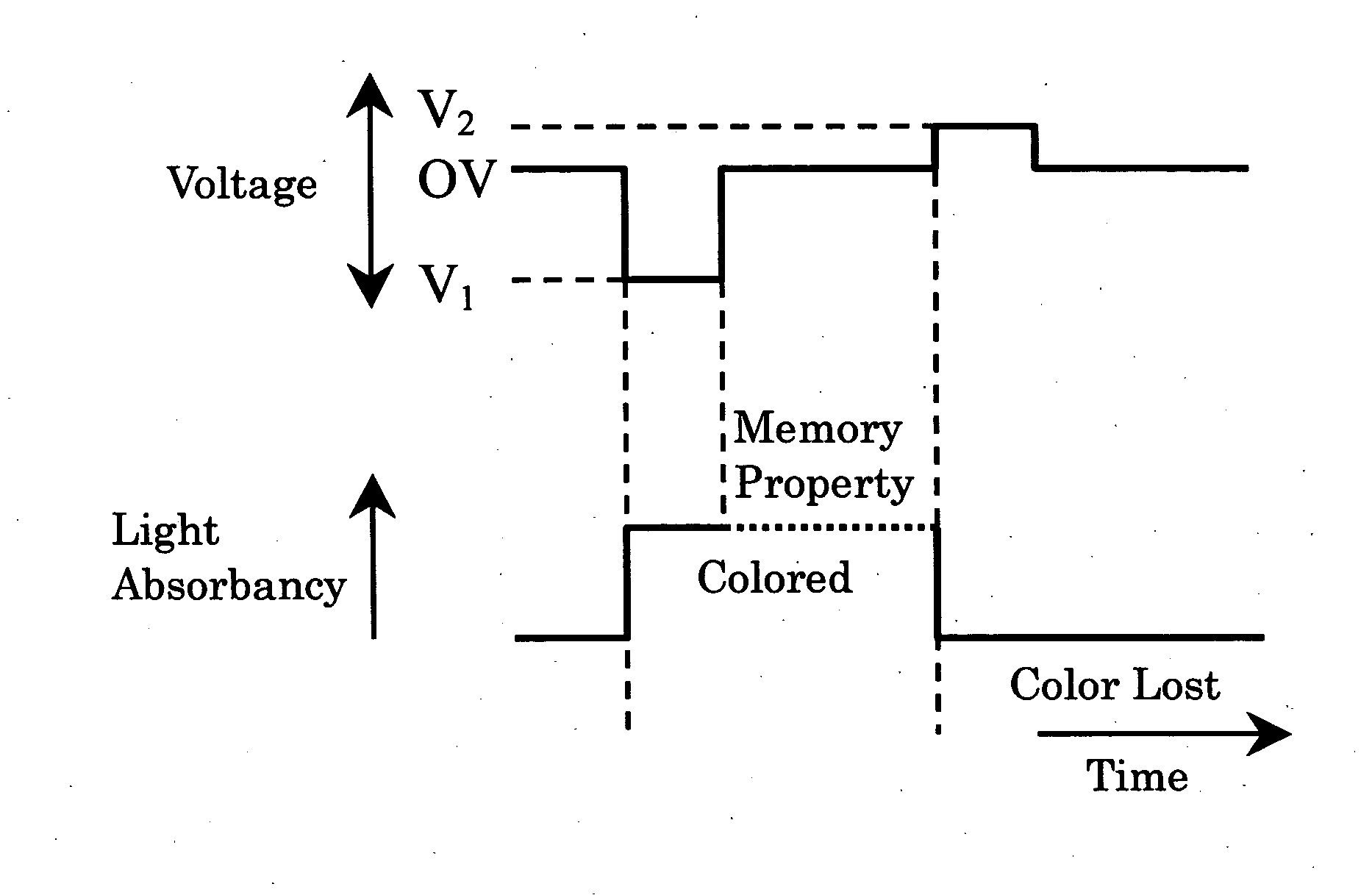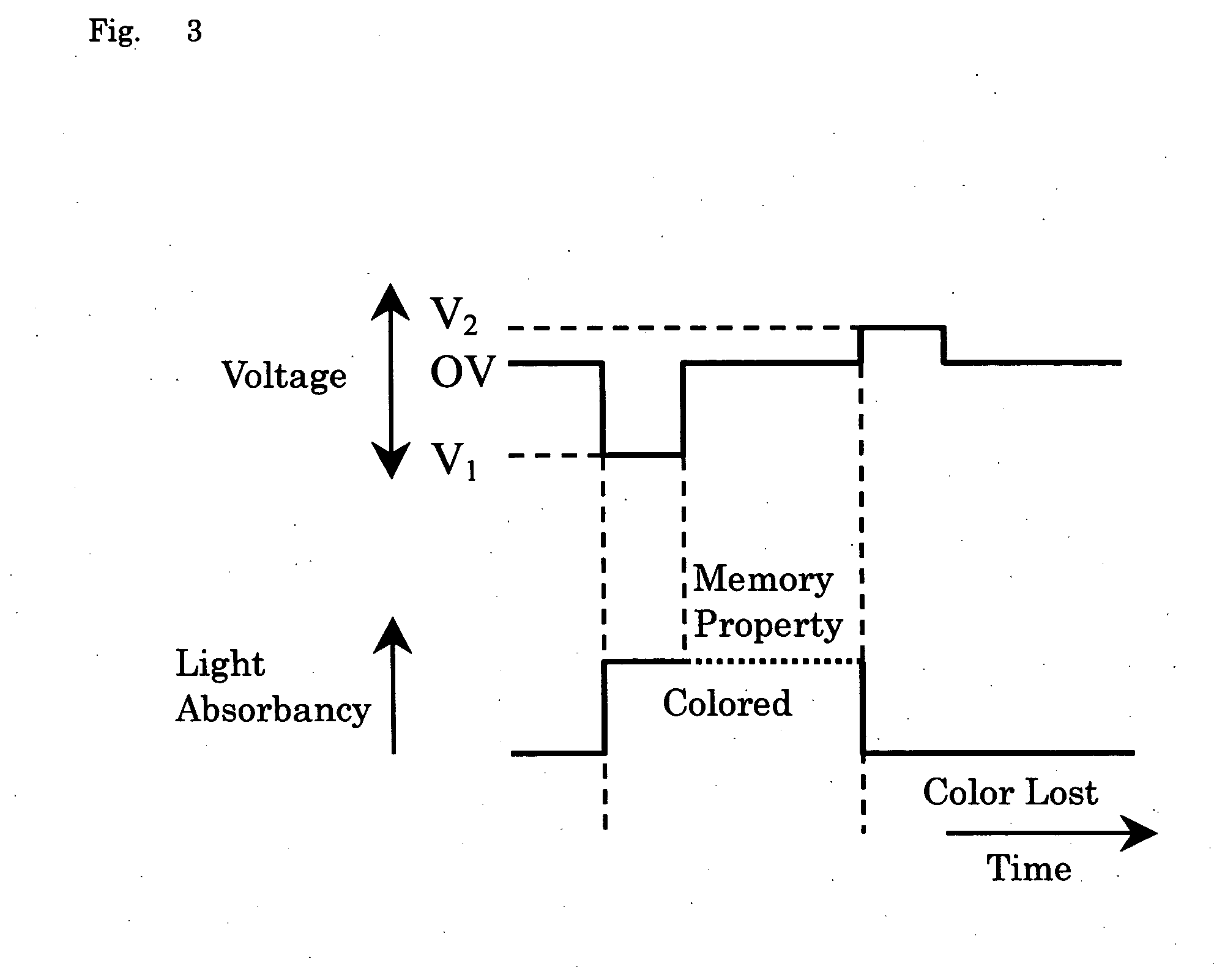Display device
a technology of display panel and display image, which is applied in the direction of static indicating device, optics, instruments, etc., can solve the problems of reducing the effective display area, the on-screen display image is difficult to be seen at dark places, and the display panel fails to offer eye-friendly display performance with enough contrast properties, etc., to achieve the effect of improving light-emitting display characteristics and prolonging the life of reflective display characteristics
- Summary
- Abstract
- Description
- Claims
- Application Information
AI Technical Summary
Benefits of technology
Problems solved by technology
Method used
Image
Examples
example 1
[0078] A square flat display panel with each side of 2.5 inches was prepared in a way which follows. Note here that each pixel was designed to consist of a mono-color electrochemical reactive element having its structure such as shown in FIG. 2. The display panel was formed so that a single pixel measures 100 μm in each side.
[0079] Firstly, a glass substrate having a thickness of 1.1 mm was used as the first substrate 1. A thin film of indium tin oxide (ITO) was then formed on the glass substrate by sputter techniques to a thickness of 100 nanometers (nm). Then, the ITO film was patterned, thus forming the first and second electrodes 6-7. An Ag film was formed by sputtering to a thickness of 100 nm, followed by patterning to thereby provide the reference electrode 10 of FIG. 2.
[0080] A glass substrate was used as the second substrate 2. An ITO film was formed thereon to a thickness of 100 nm and then patterned to form the third electrode 3. The second substrate 2 with the third el...
example 2
[0088] A display device was formed in a similar way to that of Example 1, except that the third layer 8 and ECL layer 5 were formed in a different way which follows.
[0089] Polyethyleneoxide (average molecular weight of 6000) and 0.04 mol of LiCF3SO3 per its ionic dissociation group (ethyleneoxide) were blended in an acetonitrile and then stirred, thus providing a solution. This solution was then coated by a die coater onto the EC layer 4 while controlling its thickness to 6 μm. A coated film was dried at 80° C., thereby preparing the third layer 8.
[0090] In addition, for the cell, 5% of poly[9,9-bis(3,6-dioxaheptyl)-fluorene-2,7-diyl] (BDOH—PF) was dissolved in orthodichlorobenzene, followed by injection into this cell. Thus the ECL layer 5 was obtained.
[0091] In this cell structure with the first or second electrode 6, 7 and the third layer 8 being spaced apart from each other by a distance of 2 μm, voltage application was done so that the third electrode 3 is positive or negati...
example 3
[0093] A display device was formed in a similar way to that of Example 2, except that the third layer 8 was prepared in a way which follows.
[0094] A 10 μm-thick nonwoven fabric made of polyethylene (PE) was prepared. Then, divinylbenzene and lithium (Li) styrenesulfonate were impregnated in the fabric and then heated for thermal polymerization, resulting in formation of a thin-film of 10 μm thick with a copolymer of sulfonyl group-owning styrene and divinylbenzene being impregnated in the nonwoven fabric. This was cut into a portion having the cell size, which was then put on the EC layer.
[0095] In this cell with the first or second electrode 6, 7 and the third layer 8 being spaced apart by a distance of 2 μm, voltage application was done so that the third electrode 3 is positive or negative relative to the reference electrode 10 while setting the first and second electrodes 6-7 to the same potential level. Successful achievement of coloring and color-disappearing was demonstrated...
PUM
 Login to View More
Login to View More Abstract
Description
Claims
Application Information
 Login to View More
Login to View More - R&D
- Intellectual Property
- Life Sciences
- Materials
- Tech Scout
- Unparalleled Data Quality
- Higher Quality Content
- 60% Fewer Hallucinations
Browse by: Latest US Patents, China's latest patents, Technical Efficacy Thesaurus, Application Domain, Technology Topic, Popular Technical Reports.
© 2025 PatSnap. All rights reserved.Legal|Privacy policy|Modern Slavery Act Transparency Statement|Sitemap|About US| Contact US: help@patsnap.com



